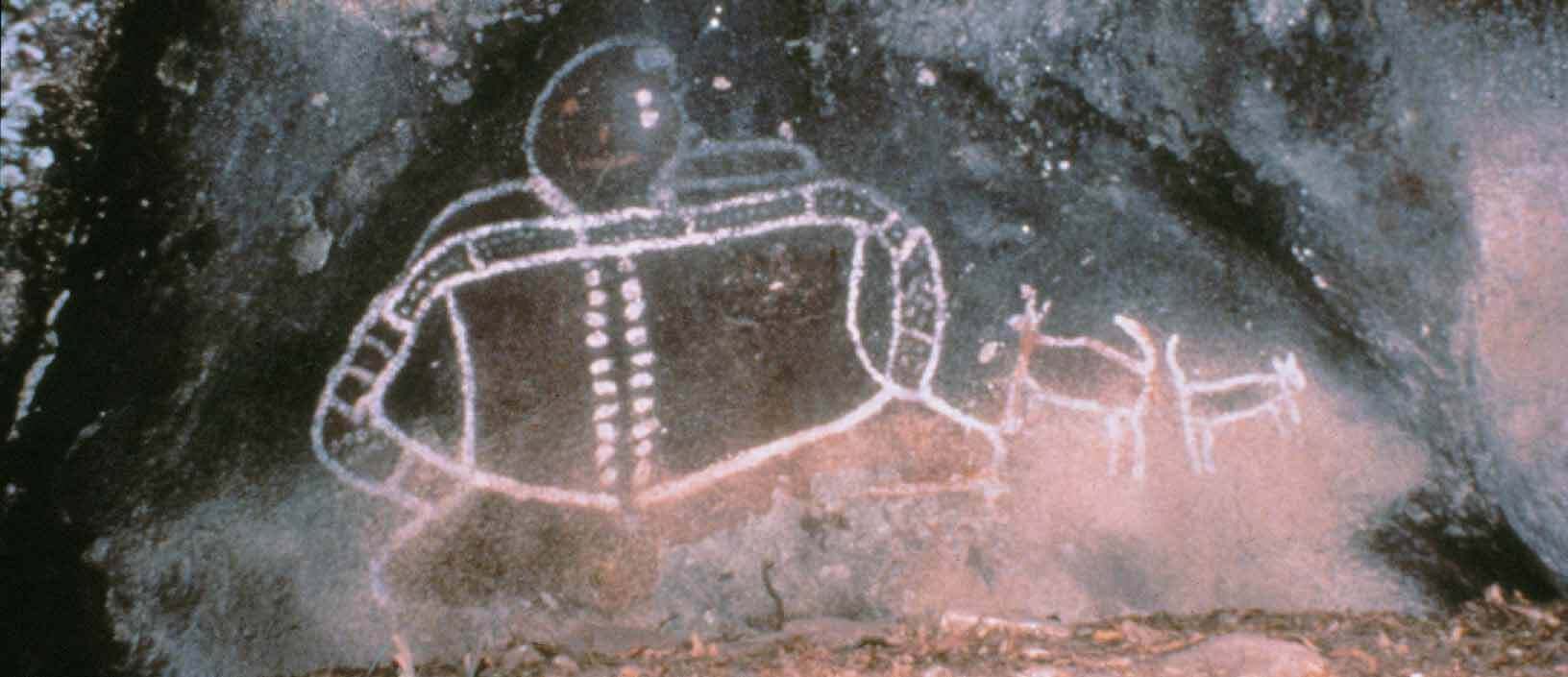
Amazing Places to See Aboriginal Rock Art in Australia
If you know where to look, Australia is an incredible record of life on earth.
Underneath a jetty at Hamelin Pool in Western Australia, for example, you’ll find the oldest colony of Stromatolites in the world. Little towers of bacteria that started making oxygen two billion years ago, creating the conditions for giant ‘scorpion like’ creatures to emerge from the oceans.
Further south in Kalbarri National Park, you can actually see the footprints left by these terrifying animals, the first to crawl out of the depths, as they scuttled off to explore 440 million years ago.
Fast forward 439,800,000 years and life hits another milestone. Early humans appear in Africa before striking out for Asia, and then, what’s thought to be up to 80,000 years ago, these trailblazing, most adventurous of human beings, also known as Aborigines, crossed into Australia and began making their mark.
And if you know where to look, you can see what marks they made, even ascertain what they were trying to tell us, their ancestors, about living on this remarkable planet.
Aboriginal Rock Art
Although Aboriginal rock art can be found all over Australia, the greatest ‘galleries’ are to be discovered in spiritual, and practical locations, because that’s where people gathered.
Symbols and drawings were used to communicate the collective knowledge of one generation, to another – passing on essential truths required to relate to each other, and the land they lived on.
And the amazing thing is, we don’t have to guess at the relevance, significance, or meaning of many of these paintings – we just ask. The stories have been passed down over the years, through the oldest living continuous culture on the earth.

1. Kakadu National Park, Northern Territory
A National Park the size of Switzerland, with one of the greatest collections of rock art in the world, Kakadu has to come first in almost any list of Aboriginal rock art.
There are two main locations to investigate, both of them easy to reach. Drive up, park, take a short walk and you’re there. Both have Ranger talks about the artwork as well, which are well worth attending if you can.
Burrungkuy (Nourlangie)
Some of the enormous plateaus rising out of the landscape in Kakadu are three billion years old, yet even in this environment Nourlangie Rock is an imposing feature, so it comes as no surprise it’s covered in rock art.
Some of the paintings provide practical information, such as the parts of an Echidna you shouldn’t eat, and others tell the stories of creation ancestors such as The Lightning Man, who brings storms and life-giving rain to the region.
Ubirr
Another plateau, Ubirr, towers over the Nabab floodplain of the East Alligator River, and has provided a safe place to shelter for thousands of years.
On the way to the lookout over Arnhem Land (best visited at sunset) you’ll pass by the ‘Main Gallery’ showing images of Barramundi, Goannas, Mullet, Catfish, Turtles and the now extinct, Tasmanian Tiger. Many of these are portrayed in the X-ray style, where anatomical details are also shown.
Rock art is an ongoing feature of Aboriginal life, so while many of the paintings are extremely old, some depict more recent events. A picture of a white man can be seen, thought to be an early farmer, and these examples of ‘contact art’ begin to tell the story of first contact with the Europeans.
In nearby Arnhem Land, other rock art shows interaction with Maccassan traders from Sulawesi, thought to be the first overseas visitors to come into contact with Aborigines.

2. Carnarvon Gorge National Park, Queensland
Perhaps not quite as easy to reach, a mere 13-hour drive inland from Brisbane and then a 6km hike, Carnarvon Gorge National Park offers some amazing examples of rock art that are well worth the effort.
At ‘Art Gallery’ & ‘Cathedral Cave’, you can see stencilling artwork that’s considered the most sophisticated of its kind in the world.
Painted with ochre, the images show tools, weapons, animals and ceremonial objects belonging to the first people to discover this oasis in the central plains of Queensland.
Red fishing nets have been created with a series of tiny triangles, painted by blowing ochre between two splayed fingers. Ochre is the medium used for a lot of rock art, however, it wears rather easily and hence, much of the artwork here is extremely fragile.
3. The Grampians National Park, Victoria
If you want to see Aboriginal rock art in Victoria, this is the place. Even though it has over 80% of Victoria’s rock art already, more sites are being discovered all the time – with a rare depiction of the mystical Bunyip being re-discovered only a couple of years ago.
Many of the roughly 200 sites are hidden, however, there are five you can visit, including the only painting of the great ancestor spirit of the Jardwadjali people – Bunjil – ever to be found.
“Bunjil created our land, our people, the plants and animals, our religion and the laws by which we live. He is the leading figure in our spiritual life, essential in teaching our young people the importance of our laws and beliefs.”
Levi Lovett, Local Custodian, Parks Victoria.
Seen as one of the most significant cultural sites in south-eastern Australia, Bunjil Shelter can be found in the Black Range Scenic Reserve near Stawell.

4. Blue Mountains National Park, New South Wales
An hour west of Sydney you cross over the Nepean River, the land begins to rise and you’ve entered the Blue Mountains National Park, one million hectares of forested plateau riven with cliffs and gorges.
95 species of eucalypt have been identified here, making it the most diverse eucalypt forest in the world, and there are an estimated 1,000 Aboriginal rock art sites dotted around the wilderness.
The most well-known is Red Hands Cave, and you can walk there from Glenbrook near the eastern edge of the park, on an 8km loop. Or, you can park in Red Hands Cave car park, for an easy 1km walk if you’re not feeling up to it.
Thought to be painted between 500 to 1600 years ago, the stencilled hand paintings are still a vibrant red, yellow and white.
Being painted with ochre, however, they will fade over time. The longest lasting of all pigments used in rock art is an iron oxide called Haematite, which is why the oldest rock art almost always exhibits that reddish iron hue.
5. Off the rock…
As we said earlier, Aboriginal rock art isn’t just something that happened a long time ago, it’s a living, ongoing feature of Aboriginal life – and in 1971 it leapt off the rock.
A school teacher near Alice Springs noticed Aboriginal men drew symbols in the sand when telling stories, encouraged them to put them on canvas and the Aboriginal art movement began.
For the very first time, people outside of Australia got to see the Dreamtime visions, creation stories and paths of the Aborigines ancestors – and the artworld was blown away.
Time Magazine art critic Robert Hughes called it “the last great art movement of the 20th century” and in 2007, the first piece of Aboriginal Art sold for over $1 million. Painted by Emily Kame Kngwarreye, who started painting when she was 80, it is fittingly entitled ‘Earth’s Creation’.
6. Finally, if you look with the right eyes
Living in Australia we’re extremely lucky to be surrounded by this wealth of human history. Not locked up in museums, or hidden away in private collections. Literally inscribed onto the very ground we walk on.
It’s there for all of us to see. And if we look with the right eyes, and listen carefully to the stories there are lessons to be learned.
From a culture that learned to take only as much as the land would allow, and lived peacefully for 80,000 years. From a culture that worked in harmony with nature, as opposed to bending the earth to their will.
Maybe that’s what the ancestors were trying to tell us about living here.
And I, personally, think it’s a message worth listening to – don’t you…?
If you’re interested in experiencing Aboriginal art first hand, we recommend checking out our Top End, Larapinta, Red Centre, Carnarvon Gorge & Grampians walks or call us at Auswalk on 1300 777 878.



Richard Roe
You might like to include Mount Borradaile in north-west Arnhem Land in your list of aboriginal rock art sites. The aboriginal rock art there is awe-inspiring and, I understand, is the largest collection of rock art in the world.
Sanyana
Hi Richard,
Thank you for your comment.
The Aboriginal rock art that we have mentioned above are just a few of our favourites that are easily accessible on our walking itineraries.